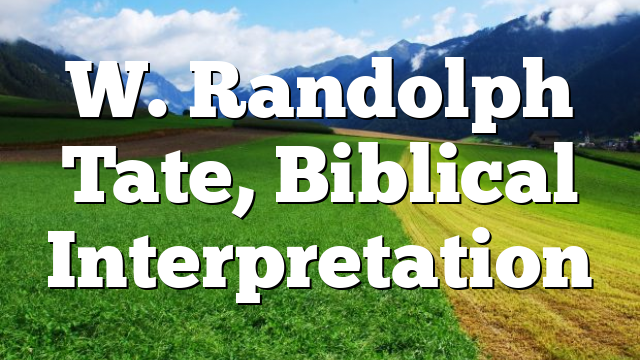Click to join the conversation with over 500,000 Pentecostal believers and scholars
Click to get our FREE MOBILE APP and stay connected
| PentecostalTheology.com



W.
Randolph (Peabody, paper.
Tate,
Biblical
Interpretation. MA: Hendrickson
Publishers,
Reviewed
by Donald A. Hagner
Springfield, Missouri, to
negotiate key
context
on the
continuing importance
two
reading
of a text in
light
considered
purely
as relation of their contents to the
for both Old and
239
An
Integrated Approach 1991).
256
pp. $14.95,
exegesis,
indeed a text. In
light
of the
the
Thus,
Within the
compass
of this
relatively
small
volume, Randolph Tate, who is Associate Professor of Biblical Studies at
Evangel College
in
offers the reader a truly helpful introductory text
the
bewildering
maze of
present-day
hermeneutics. The
to the volume is found in the
subtitle,
“an
integrated approach,” which refers to the three main sections of the book: the world behind the
text,
within the text and in front of the text.
A
comparison
of earlier standard books on biblical
interpretation with Tate’s book would show how much this field has
developed
over the last decade or two. Earlier books focused
entirely
on the world behind the
text; i.e.,
on the
exegesis
of the text in terms of the historical
of the author and
original
readers. To Tate’s
credit,
he insists
of historical-critical
regarding
it as “foundational” for
understanding
further dimensions of interpretation to be
considered, however,
of the world behind
it–i.e.,
the results of traditional
exegesis–provides
not the final
meaning
of a
text,
but
only establishes the limits within which a text is to be understood. in studying
the world behind the
text,
the reader is
only part way
to an effective
interpretation.
Attention to the world within the
text,
the focus of the newer
literary criticism,
is also
required.
In view here are the biblical documents
literature and
apart
from
any
consideration of the
real world. Tate is particularly strong in this section of the
book, dealing perceptively
with
genre
and narrative
New Testaments. His observations here are
practical and
rewarding,
and can
only
lead to more
responsible interpretation
of the
Scriptures.
The short section on
Apocalyptic
very
useful and will prevent the all-too-common misuse of this material.
at a few
points
in the discussion of the world within the text
may the reader feel intimidated
by
the technical
aspects
of
literary analysis. Tate has often made the obscure clear.
The most difficult
part
of the book concerns the world in front of the
of the reader in the
interpretive process.
The problem
here is the intrinsic
difficulty
of the
subject
matter and not
it. Some
things
are clear
enough:
the
dialogical
in
reading,
the
gaps
that must be filled in
by
the
the
progressive
character of reading, the role of
presuppositions in
interpretation,
and the
ambiguity
and multivalence inherent in all
Only
text; i.e.,
the involvement
Tate’s treatment of process
involved reader,
Literature is
again
1
240
texts. Other
matters,
such as
structuralism,
affective
criticism,
the indeterminate state of the
reader,
and
deconstructionism,
are more difficult.
Despite
his valiant
attempt,
I am not sure that Tate has been able to show the adventuresome reader how she or he can
actually employ
these new
insights
in the
interpretation
of
Scripture.
Even a sympathetic
reader
may understandably
be
tempted
to wonder whether in the end the concern for the world in front of the text amounts to
anything
more than attention to such
things
as the involvement of the reader in the determination of the
meaning
of the
text,
the
importance of a consciousness of the
interpreter’s presuppositions,
the inherent ambiguity
of
texts,
the fact that all
interpretations
fall short of
being definitive,
and so on–matters to which
many
traditional
exegetes
have long
tried to be sensitive.
Tate’s
penultimate chapter
on how methods affect
interpretation
is especially helpful, focusing
in turn on
author-centered,
text-centered and reader-centered
interpretation.
He
argues
anew and
persuasively for an approach that
regards
these different methods as complementary.
This is a very useful book. Tate has done an excellent
job
in making the
newer,
often
highly esoteric,
trends in hermeneutics understandable. His
attempt
to hold
together
all the methods
is,
in
my opinion, right-minded
and admirable. It
may be, however,
that Tate is
overly optimistic,
and that in the last
analysis
some of the reader-centered approaches
will
prove
to be more detrimental than
helpful
in the understanding
of the biblical text. Without
denying
the inevitable involvement of the
reader,
we still have as our
goal,
after
all,
not the understanding
of the readers of the
Scriptures,
but the
understanding
of the
Scriptures
themselves.
Donald A.
Hagner
is
George
Eldon Ladd Professor of New Testament at Fuller
Theological Seminary
in Pasadena, California.
2


